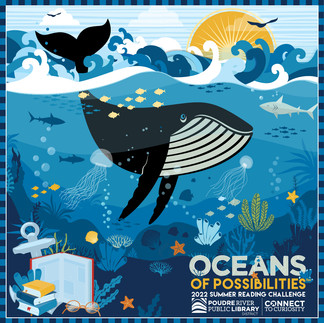Anything is possible this summer
- lcarterdesign
- May 1, 2022
- 4 min read
Updated: Jul 16

One of the projects I am most passionate about every year is the Summer Reading Challenge.
Poudre Libraries participate in a national program called Collaborative Summer Library Program. This nonprofit organization, founded in Minnesota in the late 1980’s, sought to bring libraries together to provide shared resources for children’s continued literacy learning over the summer. The CSLP hires famous illustrators to create graphic packages, which are made available for purchase to Libraries across the country. Poudre Libraries is a member of the CSLP and follows the general theme of the group for summer program planning and resources. Significantly, the Library in Fort Collins realized that developing a graphics package in-house allowed the District to reach different age groups more consistently and provided more flexibility to customize the promotional content.
The 2022 package is the eighth campaign I have created for the Poudre River Public Library District, and production activities span most of the year. Once Library staff have approved the specific theme language for the coming campaign, around September, I learn everything I can about the topic so I can compile and present three overarching aesthetics the artwork could take in November. Once the direction is confirmed in early Winter, the countdown to Summer begins.
The national theme for Summer Reading in 2022 is Oceans of Possibilities™. This is an inspiring theme because there is so much to learn about the planet’s oceans, and the need to protect these amazing sources of life and wonder has never been greater. It was interesting to consider the many ways to visually represent the movement of water, the diversity of life, and the recreational appeal of the ocean. It was a rewarding challenge to narrow the scope and create our underwater world of shipwrecks, sharks, jellyfish and sea stars.
The Summer Reading Challenge package requires a web portal, participation vehicles, community engagement messaging, event promotion, and analysis components. Participation mechanisms usually feature four different demographic groups by ages. Logs to track reading, giveaway prizes, event calendars, and other game-style pieces are created. During early Spring, an entire interactive web portal UI must be built out with buttons, avatars, sliders, and downloadable resources including coloring sheets and completion certificates. Currently this portal is duplicated in Spanish. I build all the UI components using Adobe Illustrator, and our staff web developer uploads and codes them into our website.

Equipping Librarians and Library staff to launch the program is one of the most important functions of the Communications Department. Using SharePoint, major branding elements including the logo, color palette, spot illustrations, and tools including presentation and signage templates are provided. Staff travel into school buildings to engage students and create excitement around the upcoming summer. I support this school-aged outreach by creating an animated video based on our art toolkit, which is shared in classrooms and online. There is an English and Spanish video.
Our animated video has attracted a lot of attention among libraries, and we receive phone calls and emails from librarians around the country asking how our video was created and if it can be shared. Physical school leave-behind items like bookmarks, business cards, and select participation components are designed to attract students and their families.

The promotional aspect of the campaign begins around Spring Break and continues until the summer launch at the end of May. Advertising platforms have included traditional newspaper or magazine ads, park banners, billboards, and even a drive-in-movie theater screen ad. In-building excitement is created through decorations, signage, and staff shirts. Social media coverage is also critical to our efforts, so a series of fun square Instagram images, website sliders, prize promotion, and other digital assets are pumped out across Library platforms.

The format of the summer program itself, which involves up to 12,000 participants, features not only reading activities and contests, but also in-person workshops, classes, concerts, and book clubs during summer months. These events require posters, website graphics and Library print calendar coverage.
A new item we have incorporated in 2022 is a very comprehensive learning booklet. Staff opted to include a “bingo” style game of learning activities in addition to reading books. Our newly hired Programming Coordinator led the charge to increase our support of student learning by compiling fun activities related to the bingo squares, for four different age group levels, and including bilingual content. The result is a 28-page booklet available in print or for download. I designed front and back covers, created the layout, and generated coloring-book style illustrations to liven the educational content. This will be piloting in 2022 and we are excited to see the community’s reaction to this enhanced Bingo activity.

As the summer comes to a close, we review participation statistics and create infographics to share with staff summarizing the progress. These may include pie graphics of age distribution, summaries of how many minutes were read, and a breakdown of in-person vs, online activities.
The annual Summer Reading Challenge has many moving parts, from creating the original concept, to building out the UI, to community messaging. I find it to be a very rewarding process and I enjoy the challenge of making every year special for the young readers it serves.


















Comments